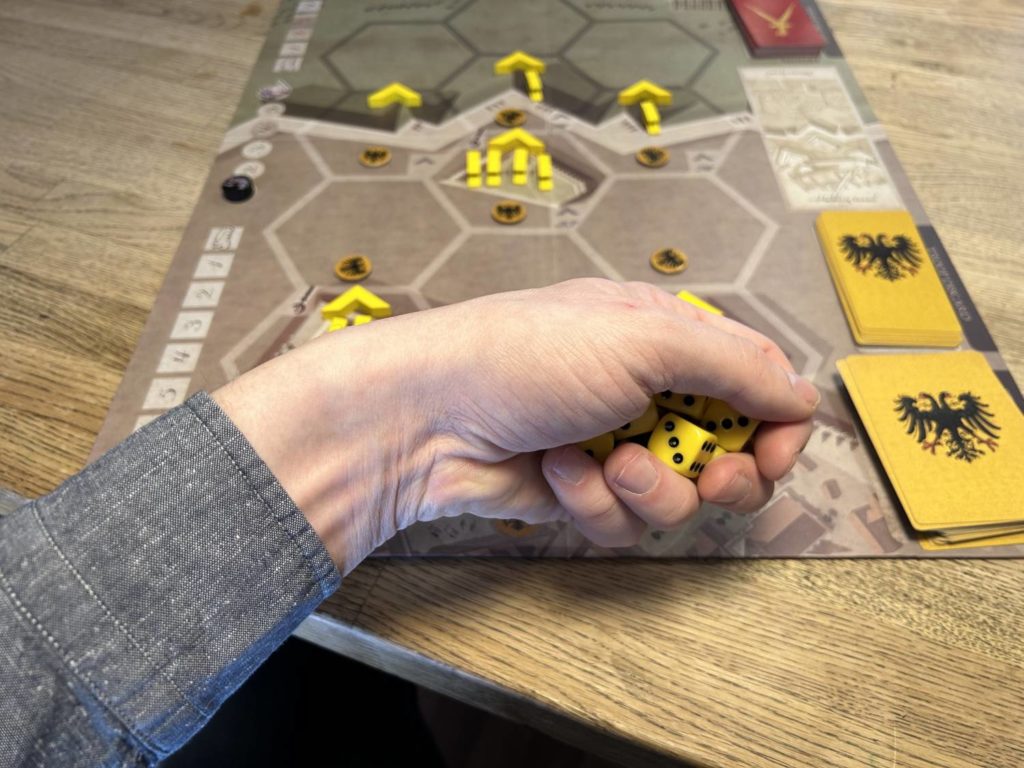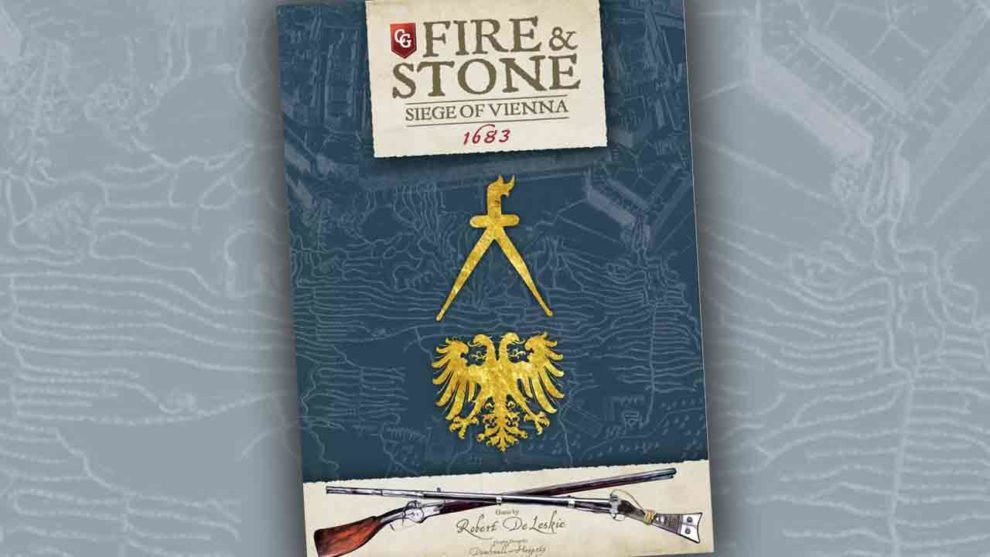Disclosure: Meeple Mountain received a free copy of this product in exchange for an honest, unbiased review. This review is not intended to be an endorsement.
I was interested in Fire & Stone: Siege of Vienna 1683 from the moment I saw it. I wasn’t interested because of the game’s beauty, though publisher Capstone Games has come up with a gorgeous and inviting product centered around bold red and yellow wooden pieces. Nor was it because of the opportunity to explore an entry-level war game for two. I was excited by the opportunity to burn Vienna to the ground.
I’ve Seen Fire and I’ve Seen Stone
Fire & Stone is set during the Ottoman Empire’s attempted 1683 siege of the proud Austrian city, then the center of the Habsburg Empire. This was the second attempted siege of the city by Turkish forces in 150 years. One cannot help but feel that the world would be better off had they succeeded. While in reality the siege lasted for months and culminated in the Battle of Vienna, when swarms of Polish and Imperial troops joined the Viennese to rout the invaders, the game compresses things down a bit. There is no culminating battle, regardless of the outcome.
 The Viennese troops start in a promising position. Their batteries of cannons look out over the entirety of the board, and they only have to hold off the Turks for five rounds. The Ottomans start out at the bottom of the board, their comparatively paltry cannons during their best. They win by taking control of particular locations within the city.
The Viennese troops start in a promising position. Their batteries of cannons look out over the entirety of the board, and they only have to hold off the Turks for five rounds. The Ottomans start out at the bottom of the board, their comparatively paltry cannons during their best. They win by taking control of particular locations within the city.
Turns are straightforward to execute. Fire & Stone uses a variation of the Card Driven Game system, eschewing action points in exchange for simpler rules where you either play a card for its event or discard it to perform a basic action. Most of the time, cards are Basic Action+, so you’ll want to use them as much as circumstances allow.
A point in this game’s favor: the basic actions are, in fact, basic. Both sides can Mine, which removes enemy fortifications, and Fortify, which adds them. The Ottomans can also Entrench, placing fortifications and consolidating cannons onto a single hex; Bombard, which can remove fortifications from Austrian-controlled spaces; and Assault, which I’ll go over in greater detail in when I cover combat. The Habsburgs can Barrage, which thins out the Ottoman troops, and Sortie, which triggers combat.
For my tastes, the combat in Fire & Stone, like the façade of the Wienzeile Jugendstil, has a bit too much going on. Each player has a troop deck, made up of troops with strengths between one and three. The first step of any contested battle—a battle over a space where both armies have units—involves both players choosing a specified number of troops from their deck and playing those cards out to the table. Dice are rolled for cannons, with each hit ejecting a random troop card. These casualties are lost for the duration of the game. Players also have single-use cards they can choose to play during combat, which can influence the outcome. At the end of all this, the player with the greater troop strength emerges as the winner.

This system has some dramatics, both in the revealing of the cards and the rolling of the dice, which I always enjoy, but I find the sum of the parts odd. Even after several games, battles never felt natural or intuitive. It isn’t a complicated system by any means, but, much like wiener schnitzel, it never feels particularly satisfying.
The German Word for “Dice” Shares the Same Root as “Throw”
Faction differences extend through available actions and player goals out into troop supply and rules governing cannon fire. The Ottomans have a fat stack of soldiers at the start of the game. To balance that out, the numerous Viennese cannons reach all over the map. Those cowards are content to stay behind their fortifications and fire down from above. It is in the Turkish interest to remove Viennese cannons as quickly as possible, but in the meantime you can afford to take a few losses.
There’s a fair amount of luck in Fire & Stone, which may limit its audience. Serious war gamers are likely to be put off by the reliance on dice for combat, while more casual players may be scared off for worrying that the system is too complicated. I myself am not sure how I feel about it, having played several games where good execution on either player’s part was stymied by poor rolls.

I discovered early on that it is much easier to stumble as the Turks than it is as the Viennese, at least in your first play. This is not a criticism. There’s nothing wrong with a game that requires understanding in order to play it well. The Turks are on a timeline, the game’s five-round structure working against them, so if you aren’t in the city by the middle of the second round at the absolute latest, you’re not going to make it.
That, however, ties into my biggest personal issue with the game: your options for creative play are limited. This is a product of its duration and its narrow scope. The Turks have to play aggressively, but playing aggressively in this design means pushing the same one or two buttons over and over again. Certainly during the early portions of the game, at least. The Austrian defenses are so good, and the Austrian cannon presence at the beginning of the game is so overwhelming, that there aren’t many viable paths to keeping the Turkish train on schedule. You either get a good hand of cards for sieging, or you mine. I like games where my options are a bit more open, where there’s more space for discovery and creativity.

If you want an entry-level war game that’s easy to learn and plays in about an hour, Fire & Stone: Siege of Vienna 1683 is a fine choice. The presentation on the table is handsome and inviting, and the rule set doesn’t approach the baroqueness of titles like Red Flag Over Paris. I can’t recommend it as an introduction to CDGs, because action points are such an important part of that system. If that’s what you’re looking for, try Watergate or the just-released Twilight Struggle: Red Sea.
That said, if the game interests you on its own merits, you’ll have a good time. It’s a straightforward siege game, where the objectives, and what you need to do to achieve them, are clear. I wish there were more tension, and I wish the combat system fell more firmly to one side or the other of the luck/strategy divide. I may not care for Vienna, but people keep going back, and they seem to love it.












Add Comment